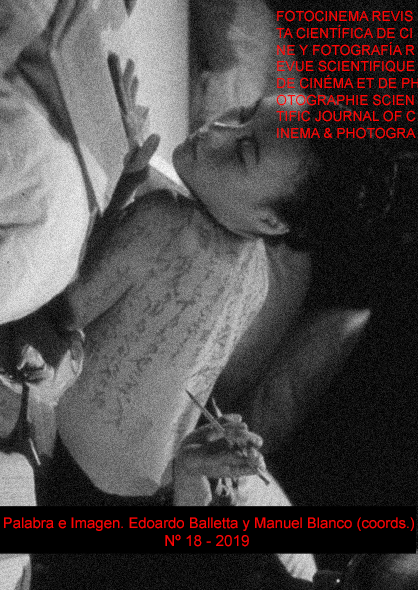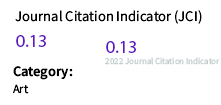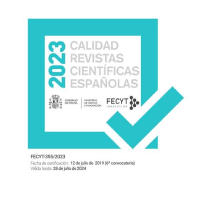Speech balloons as transposition of comic dialogue to cinema in Who wants to Jessie? (Kdo Chce Zabít Jessii?, Václav Vorlí?ek, 1966)
DOI:
https://doi.org/10.24310/Fotocinema.2019.v0i18.5529Keywords:
Czechoslovak film, Václav Vorlí?ek, Who Wants to Kill Jessie?, Comic and CinemaAbstract
Who Wants to Kill Jessie? (Kdo Chce Zabít Jessii?, Václav Vorlí?ek, 1966) is a film that, from the comedy and from forms closer to the light entertainment cinema, serves as an approach to the communication between the language specificities of comic books and cinema. In the film, the characters that appeared in an adults’ comic book took on corporeal form in the objective diegetic reality, destroying the world and communicating through text balloons. The relationship between the dialogues form from both narrative arts becomes a game that makes us rethink the graphical representation of text and dialogue in cinema, as well as the narrative differences that are shown by the seventh and ninth art due to the differentiation in synchronous and temporal forms. In the same way, the representation of characters incapable of emitting sounds, who communicate only through written text on screen, performs a though about silent movies and its evolution towards sound film, facing two historical moments of cinematographic arts.
Downloads
Metrics
References
Beaty, B. (2011). Introduction. Cinema Journal 50:3, primavera 2011, 106-110. DOI: 10.1353/cj.2011.0022.
Breton, A. (2009). Manifiesto del Surrealismo. En J. J. Pauvert (ed.) Manifiestos del Surrealismo (Trad. A. Bosch) (pp. 15-61). Madrid: Visor Libros. (Año de publicación original: 1924).
Burke, L. (2015). The Comic Book Film Adaptation: Exploring Modern Hollywood's Leading Genre. Jackson, MS: University Press of Mississippi.
Chambliss, J. C. y Svitavsky, W. L. (2013). The Origin of the Superhero: Culture, Race, and Identity in US Popular Culture, 1890-1940. En J. C. Chambliss, W. L. Svitavsky y T. Donaldson (Eds.), Ages of Heroes, Eras of Men: Superheroes and the American Experience (pp. 6-27). Newcastle: Cambridge Scholars Publishing.
Davis, B. (2017). Movie Comics: Page to Screen/Screen to Page. New Brunswick: Rutgers UP.
Eisner, W. (2000). Comics & Sequential Art. Tamarac, FL: Poorhouse Press. (Año de publicación original: 1985)
Fontaine Rousseau (2014). Batman: The Movie de Leslie H. Martinson. 24 Images, n. 170 (diciembre 2014-enero 2015) 20-20.
García, S. (2010). La Novela Gráfica. Bilbao: Astiberri.
Gasca, L. y Gubern, R. (2001). El Discurso del Comic. Madrid: Cátedra.
Hames, P. (1985). The Czechoslovak New Wave. Berkeley: University of California Press.
Hames, P. (2010). Czech And Slovak Cinema: Theme and Tradition. Edinburgo: Edinburgh University Press.
Kuhn, M. y Veits, A. (2015). Narrative Mediation in Comics: Narrative Instances and Narrative Levels in Paul Hornschemeier's The Three Paradoxes. En D. Birke y T. Köppe (Eds.), Author and Narrator: Transdisciplinary Contributions to a Narratological Debate (pp. 235-261). Berlin/Munich/Boston: De Gruyter. 10.1515/9783110348552.235, 10.1515/9783110348552.
Lefèvre, P. (2007). Incompatible Visual Ontologies? The Problematic Adaptation of Drawn Images. En I. Gordon, M. Jankovich y M. P. McAllister (Ed.), Film and Comic Books. Jackson, MS: University Press of Mississippi.
Léger, M. J. (2015). Drive In Cinema: Essays on Film, Theory and Politics. Bristol: Intellect.
Mareš, P. (2014). The Kind Millionaire, Lemonade Joe and Superman. On Czech Film Parodies. Images. The International Journal of European Film, Performing Arts and Audiovisual Communication, 14: 23 (Enero 2014), 15-24.
McCloud, S. (1995). Cómo se Hace un Cómic: El Arte Invisible (trad. Enrique Abulí). Barcelona: Ediciones B. (Año de publicación original: 1993).
Oliveira, M. C. (2018). Quadrinhos, Literatura e a Intertextualidade. Literartes, 8:1, 181-194. DOI: 10.11606/issn.2316-9826.literartes.2018.145827.
Owen, J. L. (2011). Avant-garde to New Wave. Czechoslovak Cinema, Surrealism and the Sixties. Nueva York: Berghan Books.
Smith, C. (2015). Motion comics: the emergence of a h ybrid medium. Writing Visual Culture, 7, 1-23.
Williams, B. (2017). Comic-book artifice: Olga Schoberová's hyper-femininity in Václav Vorlí?ek's Who Wants to Kill Jessie? Studies in Eastern European Cinema, 8:2, 146-159, DOI: 10.1080/2040350X.2017.1304691.
Downloads
Published
How to Cite
Issue
Section
License
All contents published in Fotocinema Revista científica de cine y fotografía are protected under the Creative Commons Attribution-NonCommercial-ShareAlike 4.0 International (CC BY-NC-SA 4.0) license. All about this license is available in the following link: <http://creativecommons.org/licenses/by-nc-sa/4.0>
Users can copy, use, redistribute, share and exhibit publicly as long as:
- The original source and authorship of the material are cited (Journal, Publisher and URL of the work).
- It is not used for comercial purposes.
- The existence of the license and its especifications are mentioned.
There are two sets of authors’ rights: moral and property rights. Moral rights are perpetual prerogatives, unrenounceable, not-transferable, unalienable, imprescriptible and inembargable. According to authors’ rights legislation, Fotocinema. Revista científica de cine y fotografía recognizes and respects authors moral rights, as well as the ownership of property rights, which will be transferred to University of Malaga in open access. The property rights are referred to the benefits that are gained by the use or the dissemination of works. Fotocinema. Revista científica de cine y fotografía is published in an open access form and it is exclusively licenced by any means for doing or authorising distribution, dissemination, reproduction, , adaptation, translation or arrangement of works.
Authors are responsable for obtaining the necessary permission to use copyrighted images.










.png)

13.png)




